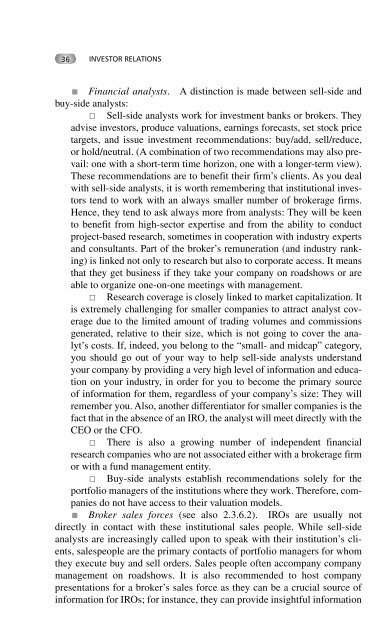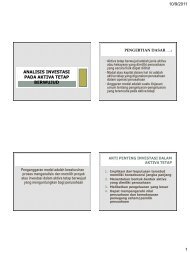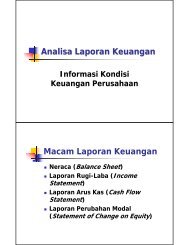Investor Relations
Investor Relations
Investor Relations
- No tags were found...
You also want an ePaper? Increase the reach of your titles
YUMPU automatically turns print PDFs into web optimized ePapers that Google loves.
36INVESTOR RELATIONS Financial analysts. A distinction is made between sell-side andbuy-side analysts: Sell-side analysts work for investment banks or brokers. Theyadvise investors, produce valuations, earnings forecasts, set stock pricetargets, and issue investment recommendations: buy/add, sell/reduce,or hold/neutral. (A combination of two recommendations may also prevail:one with a short-term time horizon, one with a longer-term view).These recommendations are to benefit their firm’s clients. As you dealwith sell-side analysts, it is worth remembering that institutional investorstend to work with an always smaller number of brokerage firms.Hence, they tend to ask always more from analysts: They will be keento benefit from high-sector expertise and from the ability to conductproject-based research, sometimes in cooperation with industry expertsand consultants. Part of the broker’s remuneration (and industry ranking)is linked not only to research but also to corporate access. It meansthat they get business if they take your company on roadshows or areable to organize one-on-one meetings with management. Research coverage is closely linked to market capitalization. Itis extremely challenging for smaller companies to attract analyst coveragedue to the limited amount of trading volumes and commissionsgenerated, relative to their size, which is not going to cover the analyt’scosts. If, indeed, you belong to the “small- and midcap” category,you should go out of your way to help sell-side analysts understandyour company by providing a very high level of information and educationon your industry, in order for you to become the primary sourceof information for them, regardless of your company’s size: They willremember you. Also, another differentiator for smaller companies is thefact that in the absence of an IRO, the analyst will meet directly with theCEO or the CFO. There is also a growing number of independent financialresearch companies who are not associated either with a brokerage firmor with a fund management entity. Buy-side analysts establish recommendations solely for theportfolio managers of the institutions where they work. Therefore, companiesdo not have access to their valuation models. Broker sales forces (see also 2.3.6.2). IROs are usually notdirectly in contact with these institutional sales people. While sell-sideanalysts are increasingly called upon to speak with their institution’s clients,salespeople are the primary contacts of portfolio managers for whomthey execute buy and sell orders. Sales people often accompany companymanagement on roadshows. It is also recommended to host companypresentations for a broker’s sales force as they can be a crucial source ofinformation for IROs; for instance, they can provide insightful information











